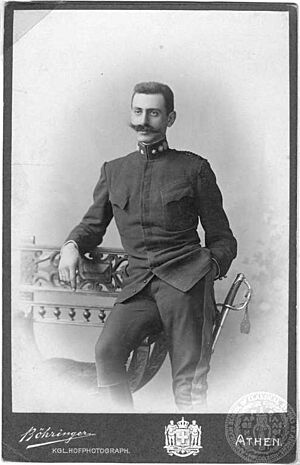Pavlos Melas facts for kids
Quick facts for kids
Pavlos Melas
Παῦλος Μελᾶς |
|
|---|---|

Pavlos Melas in uniform.
|
|
| Nickname(s) | Kapetan Mikis Zezas Καπετάν Μίκης Ζέζας |
| Born | 29 March 1870 Marseille, Second French Empire |
| Died | 13 October 1904 (aged 34) Statitsa, Ottoman Empire (now Melas, Greece) |
| Buried | |
| Allegiance | |
| Service/ |
|
| Years of service | 1891–1904 |
| Rank | Second lieutenant |
| Battles/wars |
|
| Alma mater | Hellenic Army Academy |
| Children | 2 |
| Relations | Michail Melas (father) Vasileios Melas (brother) Anna Mela-Papadopoulou (sister) Natalia Mela (granddaughter) Ion Dragoumis (brother-in-law) |
| Other work | Member of the Ethniki Etaireia Member of the HMC |
Pavlos Melas (Greek: Παύλος Μελάς, Pávlos Melás; born March 29, 1870 – died October 13, 1904) was a brave Greek soldier and a key figure in the fight for Macedonia. He was an artillery officer in the Hellenic Army, meaning he was trained to use large guns. Pavlos Melas is remembered as one of the first Greek officers to join the Macedonian Struggle, a period when Greeks fought to protect their people and land in Macedonia.
Contents
Early Life and Military Training
Pavlos Melas was born in Marseilles, France. His father, Michail Melas, was an important person who became a MP and even the mayor of Athens. Pavlos came from a wealthy and respected Greek family.
When he was young, Pavlos moved to Athens to study. He later joined the Army and graduated from the Hellenic Army Academy in 1891. He became an artillery lieutenant. In 1892, he married Natalia Dragoumi. Her father, Stephanos Dragoumis, was a politician from Kastoria. Pavlos and Natalia had two children, Michael and Zoe.
Pavlos Melas also became a member of the Ethniki Etaireia, a group that worked to support Greek interests. He fought in the Greco-Turkish War of 1897.
Fighting for Macedonia
Pavlos Melas was very concerned about the situation in Macedonia. At that time, Macedonia was part of the Ottoman Empire. Many different groups were fighting for control there. Pavlos worked with his brother-in-law, Ion Dragoumis, who was a Greek consul in Monastir (now Bitola). They also worked with local leaders like Kottas Christou and Bishop Germanos Karavangelis to raise money. This money was used to help Greek efforts in Macedonia.
After a major uprising in 1903, Pavlos Melas decided to go into Macedonia himself in June 1904. He wanted to see the situation firsthand. He also hoped to create a military group to fight against both the Bulgarian groups, known as Komitadjis (from the Internal Macedonian Revolutionary Organization, IMRO), and the Ottoman Turks.
Pavlos Melas's Death
In July 1904, Pavlos Melas returned to Macedonia. He used a secret name, "Captain Mikis Zezas" (Καπετάν Μίκης Ζέζας), to hide his identity. He led a small group of soldiers and fought against the VMRO.
On October 13, 1904, Pavlos Melas was surrounded by Ottoman forces in a village called Siatista. He was killed during this fight. Later, after this area became part of Greece, the village was renamed Melas in his honor.
After Pavlos Melas died, the Greek efforts in Macedonia became even stronger. This led to success in stopping the Bulgarian Komitadji groups, especially in western and central Macedonia. These areas were later joined with Greece after the Balkan Wars.
His Lasting Legacy
Pavlos Melas is seen as a hero and a symbol of the Greek fight for Macedonia. Many of his personal items are kept in museums. You can see them at the Museum of the Macedonian Struggle in Thessaloniki and the Pavlos Melas Museum in Kastoria.
His granddaughter, Natalia Mela, became a famous sculptor.
Images for kids
-
A photograph of Pavlos Melas as a second lieutenant in the Greek Army.
-
Pavlos Melas as a second lieutenant in the Greek Army. Portrait by Georgios Jakobides.




